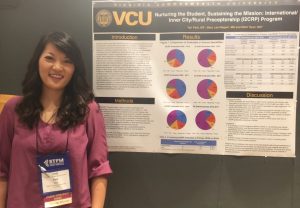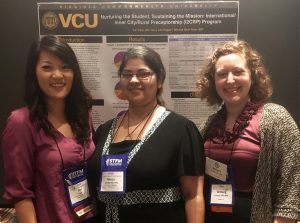
The Class of 2017’s Yeri Park presents at the 2017 Society of Teachers of Family Medicine Conference on Medical Student Education, where she showed that I2CRP graduates are more likely to match to primary care specialties than their classmates.
By 2030, the U.S. could see a shortfall of as many as 43,100 primary care physicians, according to the latest research from the Association of American Medical Colleges. That’s not even taking into account the doctors who are already needed to treat patients in medically underserved areas. Meeting their needs would require additional doctors, bringing the shortfall closer to 100,000 physicians — with nearly three-quarters of those doctors needed in urban areas.
The VCU School of Medicine is doing its part to answer the call through the International/Inner City/Rural Preceptorship, a four-year program for students who declare an interest in and commitment to working with medically underserved populations in urban, rural or international settings.
New findings show I2CRP graduates are more likely to match to primary care specialties than their classmates — 70 percent compared to 44 percent. That’s according to research by the Class of 2017’s Yeri Park, who presented her findings at the 2017 Society of Teachers of Family Medicine Conference on Medical Student Education in Anaheim, California, in February. She was one of 20 students across the country chosen for a national scholarship award to attend the conference.
“From the time the program’s first participants graduated in 2000 to 2016, about 37 percent of I2CRP graduates entered family medicine compared to 10 percent for graduates across the medical school,” Park says. “In other primary care fields, 14 percent of I2CRP graduates went into pediatrics compared to 10 percent of all graduates and 4 percent compared to 2 percent for med/peds.”

Park connects with I2CRP graduates Nancy Pandhi, M’01, and Bethany Howlett, M’12, at the STFM national conference.
For internal medicine, the program’s graduates are on par with the rest of the medical school with 18 percent of I2CRP graduates entering the field compared to 21 percent for graduates across the school.
The results pleased Mark Ryan, M’00, H’03, I2CRP medical director and assistant professor in the Department of Family Medicine and Population Health, who says the driving goal of the I2CRP program is to increase the number of students selecting primary care careers with a focus on underserved communities or underserved fields.
“We were really excited,” he says. “Yeri put in a great deal of resource-intensive work and to know that the program does seem to have a meaningful, valuable outcome is really rewarding.”
The research also showed that of the I2CRP graduates who have completed residency training, 30 percent are working in medically underserved areas and 23 percent are working in health professional shortage areas.
“That means one in four of our students who graduated in the program’s first 12 years is currently working in a medically underserved setting,” Ryan says. “We think that’s a robust number.”
Fighting the physician shortage
The dream of a career in medicine often comes with a heavy burden of debt that may influence future physicians who choose a specialty because of its earning potential and not because it’s a field they are passionate about.
Ryan says this is a defining factor for the shortage of primary care physicians. “Primary care doctors are paid 60 to 70 percent of an average specialist’s salary. Every year that salary separation grows, our family medicine matches slow; when it narrows, family medicine matches rise. It’s a near two-decade long trend.”
In the Class of 2016, only 47 students graduated debt-free. The rest carried an average debt of more than $180,000. Scholarships can help ease the burden for students such as Park, a recipient of multiple scholarships during her medical school career. Even so, the partial scholarships did not fully fund her tuition and fees.
“Financial hardship was always on my mind at the beginning of each school year,” Park says. “Knowing that I wanted to pursue primary care, this was a constant conversation between myself and my colleagues — whether I would still be happy with my choice still being in debt many years post-residency.”
The medical school launched the 1838 Campaignwith the goal of providing meaningful scholarship support for students with financial need. The $25-million campaign will build the medical school’s scholarship endowment into a resource on par with peer schools.
Full and half-tuition scholarships are most urgently needed. They are one of the medical school’s best resources for recruiting and rewarding top students.
If medical schools nationwide put up similar numbers, he points out, a workforce shortage in underserved areas likely wouldn’t exist.
As I2CRP enters its 20th year, program director Mary Lee Magee says next steps include working to understand physicians’ long-term investment in primary care. “We know our graduates are out there carrying forward their vision to make a difference,” she says. “We’d like to know more about what makes it possible to sustain this important and challenging work for the long run.”
Park connected with two I2CRP graduates at the STFM national conference: Bethany Howlett, M’12, and Nancy Pandhi, M’01. “They reminisced about their time in the I2CRP program and how it was helpful for them to spend time with like-minded peers throughout the tough journey of medical school,” Park says.
Both alumni enjoy family medicine careers in Madison, Wisconsin. Howlett practices family medicine at UnityPoint Health – Meriter, while Pandhi works as a researcher and assistant professor at the University of Wisconsin’s Department of Family Medicine and Community Health. She researches ambulatory care redesign for vulnerable populations in addition to practicing at the William T. Evjue Clinic of Access Community Health Centers.
Park is eager to follow in their footsteps. Enrolled in fmSTAT, the medical school’s four-year program designed to nurture and sustain students committed to careers in family medicine, Park recently learned she will complete family medicine residency training at Greater Lawrence Family Health Center in Massachusetts.
An aspiring doctor since she was a young girl, Park says the conference motivated her to encourage the next generation of family medicine physicians. “As someone who has highly benefited from the support and guidance from my faculty mentors, I’m looking forward to sharing my love for family medicine with future students.”
By Polly Roberts
Learn more >>